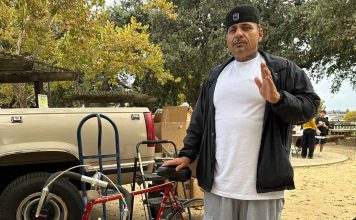Gilroy
– When Adrianna Zepeda told one of her best friends that she was
running for the presidency of Gilroy High School’s Gay Straight
Alliance earlier this year, their friendship ended.
Gilroy – When Adrianna Zepeda told one of her best friends that she was running for the presidency of Gilroy High School’s Gay Straight Alliance earlier this year, their friendship ended.
“This must mean you’re gay,” her friend insisted.
“I told her, ‘You’re forgetting the ‘straight’ in Gay Straight Alliance,'” Zepeda said.
Since she took office, the freshman has endured some teasing from classmates, but has tried to make her message clear: Discrimination is unacceptable on the GHS campus.
She and about 15 other GHS students and four teachers participated in the Day of Silence on April 13. The annual demonstration calls for participants to remain silent all day to symbolize the oppression gay, lesbian and transsexual individuals feel every day.
The national protest has sparked debate between GUSD teachers, board members, parents and students regarding teachers participating in the event during class time.
However, the controversy surrounding the demonstration has almost overshadowed its original purpose.
In meetings requested by GUSD Superintendent Edwin Diaz and GHS Principal Bob Bravo last week and Thursday, several students reported that they had been harassed or had witnessed instances of harassment on campus.
“(Two students) were poked and prodded and called ‘lesbos’ for participating,” said GSA advisor Sally Enriquez. “And no one did anything.”
Students claim the teacher saw the poking, but did nothing to stop it.
Enriquez and Karen Hockemeyer, another teacher who participated in the Day of Silence, received identical letters of hate mail at the school two days after the protest.
“It’s kind of a jolt in the gut,” Hockemeyer said.
At the GUSD school board meeting following the demonstration, some parents called for the firing of Enriquez.
“I don’t feel I have to defend myself because I’m standing up for students,” Enriquez said. “I will never apologize for that. That’s my job. … I did more my job that day then when that teacher who didn’t speak up when my students were being called ‘lesbos.'”
Under the California Student Safety and Violence Protection Act of 2000, designed to create a safe learning environment, students attending public schools are protected from discrimination based on their sex, ethnic group identification, race, national origin, religion, and mental or physical disability. A provision was later added called AB 537 that includes discrimination based on one’s actual or perceived sexual orientation and gender identity.
In accordance with this act, schools must investigate and respond to complaints filed at a school within 60 days. Schools must also provide protection for the student after a complaint is filed.
“If a teacher is not protecting a student, the teacher is not doing their job,” Hockemeyer said.
At GHS, if a student is harassed for any reason, a formal written complaint should be filed by either the student or teacher in the discipline office describing in the incident in its entirety.
“It’s up to the teacher to report it, and the administration to follow up,” said Rita Quintero who runs the GHS discipline office. According to Quintero only a handful are reported each year.
According to a 2004 study conducted by the University of California, San Francisco, half of young gay and bisexual men under 21 experienced anti–gay harassment.
“I have to believe that things go unreported,” Principal Bravo said, attributing the silence to a fear of physical or social retaliation.
Jasmine Hyatt is not one of those students.
“There’s no punishment for calling people fags (during class),” she told Bravo and Diaz at the meeting Thursday.
Hyatt informed the administrators of instances where a student was kicked because he was perceived to be gay. “The teacher never did anything about it. No one even saw anything wrong with it,” she said.
Other students reported situations where students freely use the terms “fag” and “homo,” without receiving discipline the teacher.
“The same kind of rules should apply to everyone. If I were to call someone a fag or a homo, nothing would happen, but if I were to call a teacher one – I’d get suspended or at least a detention,” Hyatt vented.
Enriquez explained that among the GHS faculty, language is tolerated on different levels. In some classrooms, teachers are quick to correct students, and others simply do not perceive that there was the intent to harass.
One phrase heard throughout the campus is, “That’s so gay,” which some students find offensive, she said.
“It’s all in fun when no one gets hurt,” Enriquez said. “But people get hurt. (Students) don’t get that that could be considered a form of sexual harassment.”
Both Enriquez and Hockemeyer enforce the district’s anti–harassment policies in their classrooms. The only problem is catching students in the act.
To remove a student from the classroom, teachers must specifically hear or see students in the act. Otherwise, they are limited in their response, Hockemeyer explained in an interview last week.
“It’s very disheartening not to catch,” she said. “In a normal mainstream classroom, if there’s a stand out (academic) student, especially in the lower grades, if they have any other differences, they are targeted.”
Students presented Diaz and Bravo with solutions including a staged intervention, a concert promoting tolerance, and small classroom discussions regarding discrimination.
“I was sad to hear they felt it was acceptable for people to call them names and no one interfered,” Diaz said. “We’re going to try to make a difference.”














